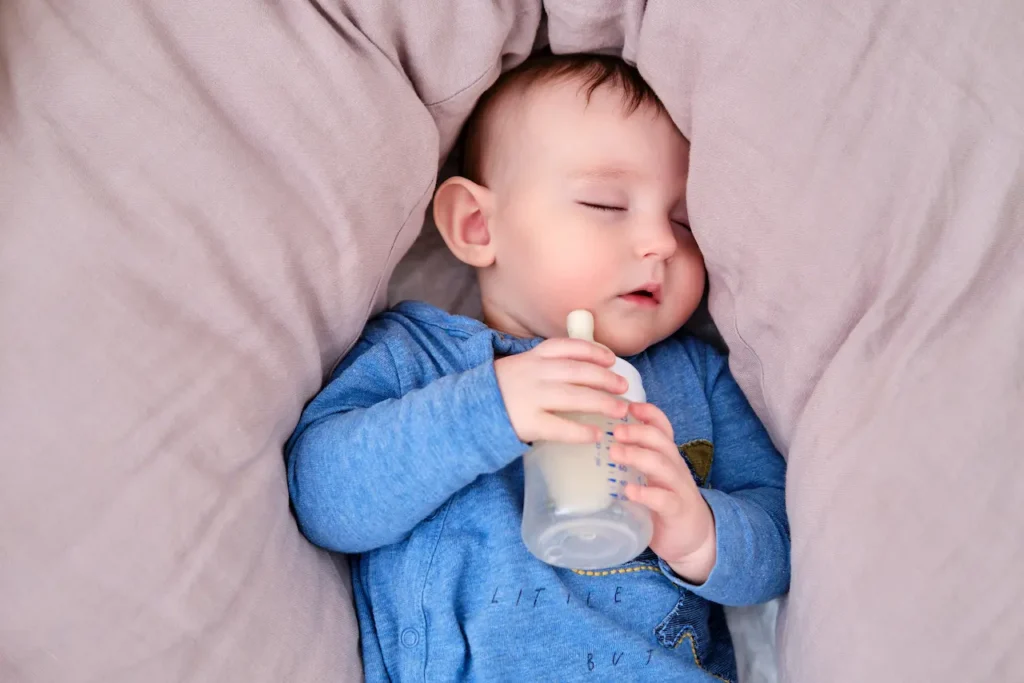Breaking the Bedtime Milk Habit
The Ultimate Guide for Weaning your Toddler off the Bedtime Bottle
Why is it Important to Wean Your Toddler Off the Bedtime Bottle?
It’s natural for parents to want to comfort and secure their toddlers. However, a bedtime bottle that contains milk can negatively impact your child’s health over time. The prolonged use of a bottle at bedtime can cause your child to lose their teeth, disrupt his sleep cycle, and lead to difficulty weaning. Experts say that the best time to begin the weaning is between 12-18 months. This is when the child no longer needs nighttime feedings and can start to transition from the bottle.

By eliminating the bedtime bottles, you not only support better oral health by reducing the risk of decayed teeth and other dental problems but you also give your child the opportunity to develop healthier sleep habits. By eliminating the bottle, your child will learn how to soothe themselves and develop healthier sleep habits.
What is the Best Method to Wean Your Toddler Off the Bedtime Bottle?
There are two main approaches to weaning: cold turkey and gradual easing. The best method for your child will depend on his temperament and your family’s daily routine. We’ll look at both methods.
Gradual Weaning: A Slow, Steady Approach
Gradual weaning is the process of gradually reducing the milk content in the bottle at bedtime over a few days or even weeks. Parents who don’t want to make the transition too abruptly often prefer this method. You can wean your child slowly off of the bottle by diluting milk with water, or by offering smaller portions every night. To wean your child off the bottle, you need to make sure that they feel secure and comfortable during this transition.
Dr. Jay L. Hoecker is a pediatrician who says that gradual weaning helps the child adjust to changes gradually, which minimizes disruptions to routine and reduces anxiety.
A Rapid but Intense Approach
Some parents opt for the “cold-turkey” method whereby the bottle is immediately and completely removed. This method can initially be challenging, but many parents report that it produces quicker results. Consistency is the key to success when using this method. It’s crucial to stay with your decision to stop giving the bottle to your partner, even if it is difficult at first.
Dr. Tanya Altmann is a pediatrician, author and noted expert on toddlers. She recommends that some toddlers go cold turkey to eliminate the bedtime bottles. Parents must prepare themselves for some tough nights.
Should You Choose Gradual Weaning or Cold Turkey?
Your toddler’s temperament will determine whether you choose to wean your child gradually or cold turkey. Some children can adapt to sudden changes and handle them well, while others may be overwhelmed by a sudden change. According to a study published in the journal Children’s Health, gradual weaning is less stressful for the child as well as the parent. Cold turkey may work for children who need to be thrown off the bottle and are resistant to change.
You should also consider your family dynamics. Some parents are more comfortable with the cold turkey method, particularly if they’re prepared to face some initial resistance. Consistency is the key, no matter what method you use. Be consistent with your approach and make sure everyone is on board.
Tips for Parents on How to Deal with Nighttime Milk Wake-ups
Many toddlers wake up during the night, or in the early morning, to ask for more milk. This nighttime milk request can disrupt sleep cycles for the whole family. Here are five tips that will help you guide your child to a peaceful routine and away from milk as a way to get to sleep.
Breaking the Bedtime Milk Addiction
Bedtime milk habits are often the cause of nighttime awakenings. Your child may also expect milk at night if they associate falling asleep with it. It is important to break the habit by gradually shifting the time of milk consumption. If possible, move it earlier in the day, preferably at dinnertime, so that it no longer has a link to sleep.
Tip # 2: Put the Milk in “Bed”
Create a routine where you and your toddler “put the bottle to bed” together. Take the milk from the refrigerator, give it a goodnight kiss, and then put it back in the fridge. This signifies that milk will no longer be part of your sleep routine and that you should start a new one.
Tip # 3: Be Consistent with Your Response
If your child complains, you must respond to them consistently. If you decide to check in on your child at regular intervals or stay with them until they go to sleep, stick to the same routine each night. This will help them adjust. Consistency creates a sense of security in your toddler and assures them that they are not alone.
Move Morning Milk Out of the Bedroom.
To reinforce the bottle-free sleeping routine, offer milk in only other rooms around the house. This is best done outside of the bedroom. It helps establish clear boundaries between milk and sleep, so your child can understand that milk doesn’t have to be associated with nighttime or bedtime.
Tip #5 – Use a Toddler’s Clock
A toddler clock is a useful tool for letting your child know when it’s bedtime and when it’s waking up time. These clocks show your child in colors or pictures when it is still time to go to bed and when it is okay to wake up. This can teach your child over time when to drink milk (in the mornings) and when to go to bed without it.
These strategies will help you and your child to develop healthier sleep habits.

A New Bedtime Routine Without the Bottle
To wean your toddler from the bedtime bottles, you will need to establish a new routine. This should be a comforting one that does not involve the bottle. A predictable, structured bedtime routine will help your toddler to feel safe and secure during this transition.
How to Create a New Routine for Bedtime:
- Calming Activities Before Bedtime: Relaxing activities like reading stories, singing lullabies, or gently rocking can help your child relax before bed. These activities will help your child know that it is time to go to bed.
- Introduce Comfort Objects: An adorably stuffed animal, blanket, or other familiar object can be used to replace the bottle and provide comfort.
- Establish a Regular Bedtime – Consistency is the key. To help your child’s sleep cycle, try to set a bedtime each night.
- Calm the Environment: Dimming the lights and reducing noise levels will create a calm environment that promotes sleep.
Dr. Harvey Karp is a pediatrician and the author of The Happiest Baby on The Block. He emphasizes the importance of a predictable routine for toddlers, especially when it comes to making changes, such as weaning them off the bottle.
How to Wean Your Toddler off the Bedtime Bottle
Weaning your toddler depends on their individual development. Most pediatricians suggest starting between 12-18 months. Toddlers can now get the nutrition they need during the day and no longer require nighttime feedings.
According to the American Academy of Pediatrics, prolonged bottle use can cause dental issues such as tooth decay and contribute to poor sleeping patterns.
Signs that Your Toddler is Ready to Stop Night Feedings:
- Less Interest in Milk: Your toddler may be ready for a transition if they are drinking less milk and showing an increased interest in solid food.
- Sleeping Through The Night: Your child may not need a bedtime bottle if they can sleep all night long without waking up for milk.
- Greater Independence: The signs of increased independence may include drinking from a cup, or eating by themselves throughout the day.
How to Manage Night Wakenings After Weaning
It’s normal for your toddler to resist weaning if they have been drinking from the bottle for a while. Expect sleep disturbances, meltdowns, and other challenges. This transition can take some time, so it’s important to remain patient and consistent. It may be tempting to offer a bottle of soda as a quick solution, but it is important to avoid returning to old habits. Focus on creating new routines to comfort your child and reinforce their independence. With gentle reassurance, they can learn how to soothe themselves.
Use comforting techniques such as soft, soothing words or a gentle pat on the back. You can also offer a favorite blanket or stuffed animal. It’s okay to rock or hold your child for a few moments, but you should gradually decrease this to teach them to fall asleep on their own. Consider introducing a soothing bedtime ritual such as a warm shower, soft music, or a story to make them feel more secure. These rituals will help your toddler prepare for a peaceful evening by letting them know that it is time to relax.
Avoid picking up your toddler if they continue to wake up at night. Allow them to calm down on their own. Over time, your child will learn that nighttime wakings do not mean it is time to get up or drink a bottle. Keep the environment conducive to sleep for your child. The room should be dark, quiet, and comfortable. If your child is afraid of the darkness, a nightlight or a white noise machine may be helpful.

Conclusion
Although it can be challenging to wean a toddler off the bedtime milk, there are many long-term benefits. With patience and consistency, your toddler will develop better sleeping habits and dental health. This transition can be a difficult one for you and your toddler. It’s important to have empathy and understanding. Be ready to overcome obstacles and make adjustments along the way. The path to a bottle-free night’s sleep is not always linear. Be flexible and willing to try different methods. Each child is unique and will respond differently to the same approach. Ask a sleep consultant or pediatrician for advice if your child is struggling, or if you are unsure of the best approach. They can provide personalized support and solutions. By being patient and compassionate you can help your child create a nighttime routine that promotes their health but also brings peace to the family. This is only one milestone in your child’s growth. With time, you will be proud of all the positive changes that you have made.



